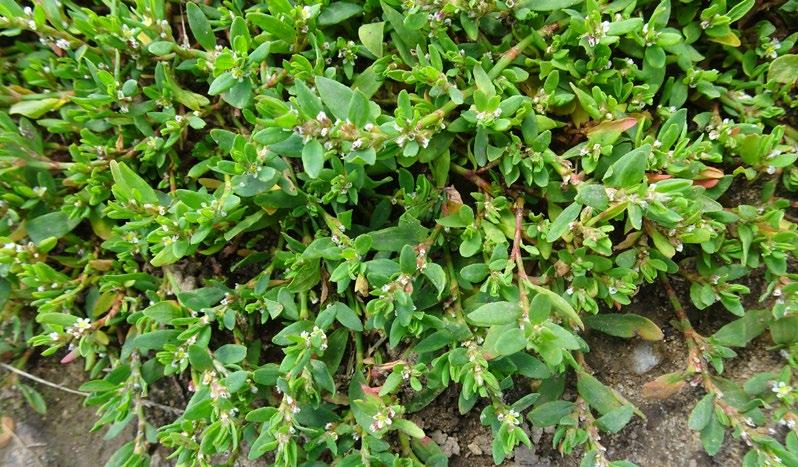
7 minute read
Bob Leaney
Common problems with field identification – the Polygonum aviculare aggregate
BOB LEANEY
Advertisement
As defined by Stace (2019), this aggregate includes four taxa: • Polygonum depressum (syn. P. arenastrum) – Equalleaved Knotgrass; • • • Polygonum aviculare s.s. – Knotgrass; Polygonum boreale – Northern Knotgrass; and Polygonum rurivagum – Cornfield Knotgrass.
The aggregate continues to cause problems on almost every meeting of the Norfolk Flora Group, both in separating P. depressum from P. aviculare s.s., and also in attempting to recognise P. rurivagum. The former problem is made worse by the fact that the main stem leaves subtending the branches, which are needed to demonstrate heterophylly or lack thereof, have usually fallen by the time the diagnostic floral and fruiting characters are apparent; but there are also frequent plants that seem intermediate and cannot be assigned to the usual species concept. Attempts to find P. rurivagum are virtually always fruitless, mainly I feel because this taxon, at least nowadays, is actually very rare!
Polygonum depressum (Equal-leaved Knotgrass): Low, decumbent form with all small, dark green, elliptic, blunt-tipped leaves. Bob Leaney
I have no experience of P. boreale, which is confined to Scotland, so will not deal with this taxon. It differs from the other three taxa within the complex mainly in having obovate leaves with quite long petioles that are well exserted from the ochreae (fused stipules).
Our usual nomenclature and identification characters derive from a large morphometric study by Styles almost 60 years ago (Styles, 1962). He recognised P. aviculare s.l. as being comprised of the four species listed above, and considered species status for P. aviculare and P. depressum as being ‘beyond doubt’. However, he was less sure of the specific status for P. rurivagum, and experienced considerable difficulty in tracing populations, either in the field or in herbarium collections. Styles’ study suggests that P. rurivagum was very scarce even in his time, and confirms the supposition that the species is rare rather than under-recorded nowadays.
POLYGONUM AVICULARE S.S.
• Procumbent to erect • Leaves lanceolate, paleish grey-green, acute tipped, some large • Heterophyllous
Achene hardly protuberant; petaloid margins of perianth segments expanded
Perianth dissected to c. 2/3
Fruit length 2.5–3.5 mm
Ochrea teeth short (c.5 mm)
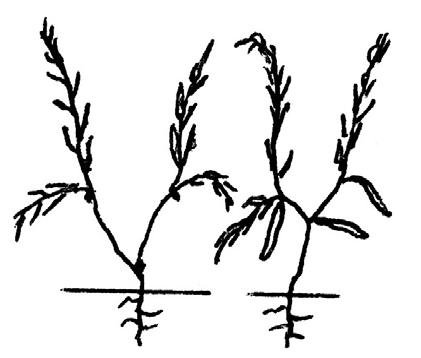
Main stem leaves often lost (applies to all spp.) POLYGONUM RURIVAGUM

• Usually ascending to erect; occasionally protuberant • Leaves linear to linearlanceolate; some over 25 mm long and ≤4 mm wide • Heterophyllous Achene slightly protuberant; perianth segments narrow at tips, not overlapping Perianth dissected to c. 2/3 Ochrea teeth long (c. 10 mm)
Ochrea
Fruit length 2.5–3.5 mm
Heterophyllous
Main stem leaves
POLYGONUM DEPRESSUM
Heterophyllous Main stem leaves
• Densely leafy with short internodes. • Plant usually procumbent or low decumbent. Perianth dissection to c. ½ way. Ochrea teeth short (c. 3 mm)
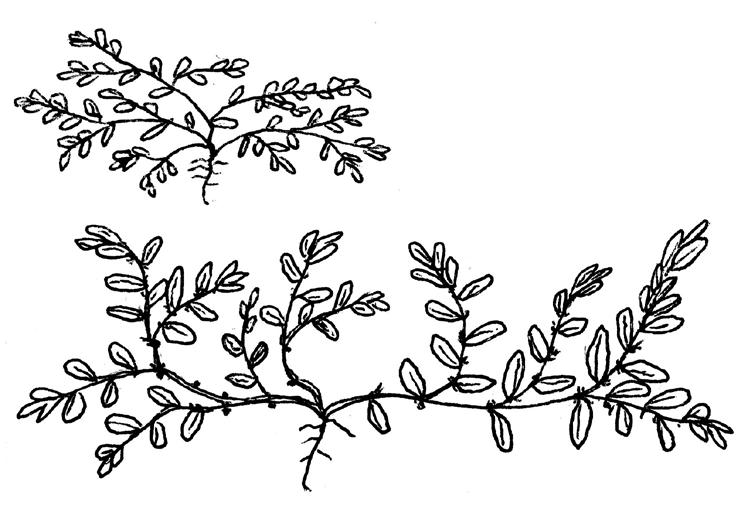
Fruit length <2.5 mm
Main stem leaves Branch • Leaves elliptic, dark green, blunttipped. • Leaves all small; main stem leaves same size as those on branches (but usually lost) (isophyllous).
Interestingly, another extensive morphometric study of the complex, by Meerts et al. (1990) in Belgium, found no plants corresponding to P. rurivagum and only enough clustering to assign P. aviculare and P. aequale (P. depressum) to subspecies status; similarly, Stace in his 4th edition Flora (Stace, 2019) states that the four taxa might be better treated as subspecies; the second Docks and Knotweeds Handbook (Akeroyd, 2014) takes a similar approach.
P. rurivagum
Polygonum aviculare and P. depressum
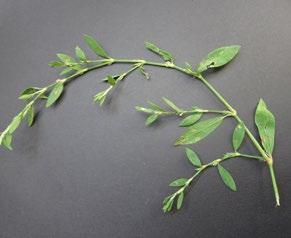

Polygonum aviculare and P. depressum can usually be separated by a combination of habit, leaf shape and leaf colour. P. depressum is characteristically procumbent to decumbent, and densely leafy, with short internodes; P. aviculare s.s. is usually ascending to erect and has a more open structure, but is frequently procumbent or decumbent on pavements or other trampled substrates.
Looking for heterophylly is usually precluded by the fact that the main stem leaves fall off early in both taxa, but the branch leaves are also very different: small, elliptic and dark green, with rounded to sub-acute tips in P.depressum and usually much larger, lanceolate to narrowly ovate and pale grey-green, with acute tips in P. aviculare s.s. Perianth dissection usually correlates well with these leaf characters: to about half way down in P. depressum and about two-thirds in P. aviculare. If leaf and perianth characters are equivocal, fruit length and shape can be very useful in this paring (but not in P. aviculare vs P. rurivagum). The achenes can be obtained by rubbing the flowers vigorously between the fingers and thumb, and the characteristic shape is best viewed by holding the fruit by the base and looking down at the pointed apex, or by transection with a scalpel blade at home later.
The main spotting feature for P. rurivagum is the very long, narrow leaf shape, which should be linear or linear-lanceolate, with a parallel-sided central section, not elliptic or broadly lanceolate. Short leaves with a width of below 4mm are not diagnostic; the leaves should be at least 25mm long for a maximum width of 4mm to be indicative of P. rurivagum. Another misconception that causes problems is the belief that red flower colour is diagnostic for P. rurivagum. Styles did describe the flowers of P. aviculare s.s. and P. depressum as ‘pink-purple’ and those of P. rurivagum as ‘red’, but dismissed flower colour as a reliable diagnostic character. Another common assumption is that the achenes of P. rurivagum are protuberant, but the degree of protuberance is very variable and not nearly as marked as in P. oxyspermum (Ray’s Knotgrass). The exposure of the achenes in P. rurivagum is mainly between the perianth segment tips, which are narrower and with less expanded, white petaloid margins than the other two taxa. Long ochreae teeth are another feature of P. rurivagum that is worth looking for (Poland & Clement, 2020). Above: Polygonum depressum – low, decumbent form, all small, dark green, elliptic, blunttipped leaves and isophylly; right top: P. aviculare – long internodes, large, mid green, ovate to lanceolate, acute-tipped leaves and heterophylly; bottom right: P. rurivagum – long linearlanceolate leaves <4 mm wide and heterophylly. Bob Leaney
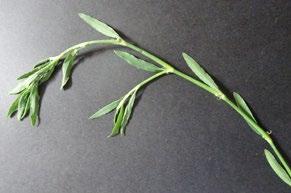
However, plants that fit P. rurivagum as regards leaf and flora characters can lack this feature, and often the teeth are so frayed and randomly directed as to be impossible to measure.
Conclusion
The majority of plants within the P. aviculare complex can be readily identified in the field using the bullet points shown in the illustration.
However, one finds a lot of intermediates between P. aviculare s.s. and P. depressum, mainly with regard to habit and leaf shape. The most frequent intermediates we seen in Norfolk have the ascending or erect habit and acute-tipped leaves of P. aviculare s.s., but the leaves are crowded together and uniformly small as in P. depressum. Such forms should usually be recorded as P. aviculare agg., but if it seems important to make the separation, material should be taken home for further examination. Perianth dissection, achene length and shape on transection should all point in one direction for a reliable identification to be made.
Suspected P. rurivagum should always be taken home, for this taxon is probably being overrecorded and in reality very scarce. Crucial to this determination is the finding of long, linear leaves, some at least 2.5cm long, but <4mm wide. Narrow tips to the perianth segments exposing the achenes should also be present on the majority of the flowers.
References
Akeroyd, J.R. 2014. Docks and Knotweeds of Britain and Ireland (2nd edn). Botanical Society of Britain & Ireland, London. Meerts , P. Briane, J.-P. & Lefebvre, C. 1990. A numerical taxonomic study of the Polygonum aviculare complex (Polygonaceae) in Belgium. Plant Syst. Evol. 173: 71–89. Poland, J. & Clement, E.J. 2020. The Vegetative Key to the British
Flora (2nd edn). John Poland, Southampton. Stace, C.A. 2019. New Flora of the British Isles (4th edn).
C & M Floristics, Middlewood Green, Suffolk. Styles, B.T. 1962. The taxonomy of Polygonum aviculare and its allies in Britain. Watsonia 5: 177–214.
Bob Leaney
122 Norwich Road, Wroxham, Norwich NR12 8SD

Polygonum aviculare s.s. Note long internodes, large, mid green, ovate to lanceolate, acute-tipped leaves and heterophylly. John Norton
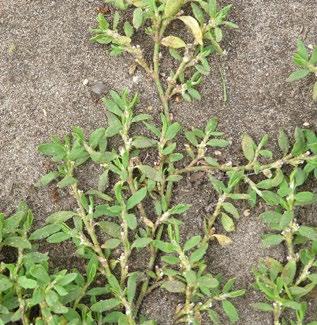
Polygonum depressum. Showing low, procumbent habit and all small, dark green, elliptic, blunt-tipped leaves. Mike Crewe
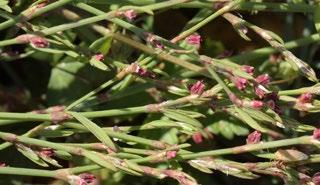
Polygonum rurivagum. Long linear-lanceolate leaves, <4 mm wide and heterophylly. This photo also shows the slightly protruding achenes. John Norton










